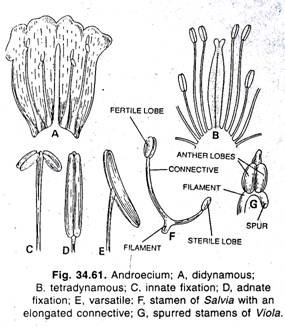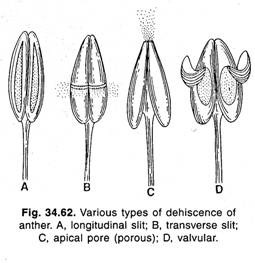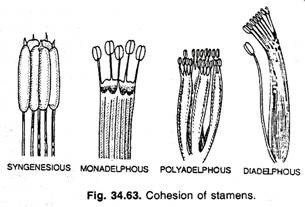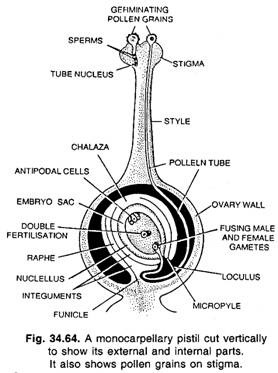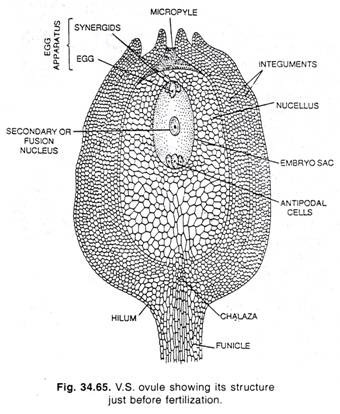ADVERTISEMENTS:
Let us Learn about the Structure of Flower. After reading this article you will learn about: 1. Introduction to Structure of a Flower 2. Structure of Various Parts of a Flower.
Introduction to Structure of a Flower:
The vegetative shoot shows unlimited growth, whereas the flower shows the limited growth. In flower, the apical meristem ceases to be active after the formation of floral parts. Anatomically the flower is a determinate stem with crowded appendages with internodes much shortened or obliterated.
The appendages are of leaf rank but differ from those of the vegetative stem, in function and shape. Here the flower has been treated on the basis of the concept of homology between the flower and the shoot in their phylogeny and ontogeny.
ADVERTISEMENTS:
The flower consists of an axis, also known as receptacle and lateral appendages. The appendages are known as floral parts or floral organs. They are sterile and reproductive. The sepals and petals which constitute the calyx and corolla respectively are the sterile parts. The stamens compose the androecium, whereas the free or united carpels compose the gynoecium.
Structure of Various Parts of a Flower:
Pedicel:
The pedicel and receptacle have typical structure, with a normal vascular cylinder. The cylinder may be unbroken or it may contain a ring of vascular bundles. In the region where floral organs are borne, the pedicel expands into the receptacle.
The vascular cylinder also expands and the vascular bundles increase somewhat in number, and finally traces begin to diverge. In the simplest cases vascular traces for different organs and whorls of organs arise quite independently, (e.g., Aquilegia).
Sepals:
The sepals resemble leaves in their anatomy. Each sepal consists of ground parenchyma a branched system and epidermis. The chloroplasts are found in the green sepals but usually there is no differentiation into palisade and spongy parenchyma. The epidermis of sepals may possess stomata and trichomes.
Petals:
The petals also resemble leaves in their internal structure. They contain ground parenchyma, a more or less branched vascular system, and an epidermis. They contain pigments-containing chromoplasts. Very often, the epidermal cells of the petals contain volatile oils which emit the characteristic fragrance of the flowers.
Stamen:
Commonly the stamen consists of a two-lobed four loculed anther. The anther is found to be situated on a slender filament which bears vascular bundle. In certain primitive dicotyledonous families the stamens are leaf-like and possess three veins, whereas in advanced types they are single veined.
The structure of filament is quite simple. The epidermis is cutinized and bears trichomes. The stomata may also be found in the epidermis of both anther and filament. The vascular bundle is found throughout the filament and culminates blindly in the connective tissue situated in between the two anther lobes.
The outermost wall layer of the anther is the epidermis. Just beneath the epidermis there is endothecium which usually possesses strips or ridges of secondary wall material mainly on those walls which do not remain in contact with the epidermis.
The innermost layer is composed of multinucleate cells; this is nutritive in function and known as tapetum. On the maturation of the pollen the tapetum disintegrates and the outer wall of the pollen sac now consists of only epidermis and endothecium. At the time of dehiscence of the anthers the pollen are released out through stomium.
Gynoecium:
The unit of gynoecium is called the carpel. A flower may possess one carpel or more than one. If two or more carpels are present they may be united or free from one another. When the carpels are united the gynoecium is known as syncarpous; when they are free the gynoecium is said to be apocarpous.
The carpel is commonly interpreted as foliar structure. The carpel of an apocarpous or syncarpous gynoecium is being differentiated into the ovary and the style. The upper part of the style is differentiated as a stigma. The stigma is sessile.
Placentation:
The ovary consists of the ovary wall, the locule or locules, and in a multilocular ovary, the partitions. The ovules are found to be situated on the inner or adaxial (ventral) side of the ovary wall. The ovule-bearing region forms the placenta. In a carpel the placenta occurs close to the margin. Since there are two margins, the placenta is double in nature. The two halves may be united or separate.
ADVERTISEMENTS:
The number of double placentae in compound ovaries is equal to number to carpels When the carpels are folded, the ovary is multilocular and the placentae occur in the centre of the ovary where the margins of the carpels meet.
This is axile placentation. When the partitions of the ovary disappear, it becomes free-central placentation. When the carpels are joined margin to margin and the placentae are found to be situated on the ovary walls, the placentation is parietal.
Thalamus:
The under-mentioned facts prove that the thalamus is a modified branch, whereas sepals, petals, stamens and carpels are modified vegetative leaves, and the flower as a whole is a modified vegetative bud.
1. The thalamus represents the axis of the floral whorls with internodes between them normally remaining undeveloped or suppressed. However, in some flowers the thalamus becomes elongated showing distinct nodes and internodes, e.g., in Gynandropsis, Cappans, etc.
ADVERTISEMENTS:
2. Sometimes the thalamus becomes elongated upwards and bears ordinary foliage leaves, and behaves as a branch, e.g., in rose.
3. A floral bud like a vegetative bud is either terminal or axillary in position.
4. The arrangement of sepals, petals, stamens and pistil, etc., on the thalamus is the same as that of the leaves on the stem or the branch, i.e., whorled, alternate, spiral or opposite.
5. The arrangement of sepals and petals with respect to each other (i.e., aestivation) is similar to that of the foliage leaves (i.e., prefoliation).
ADVERTISEMENTS:
6. The foliar nature of sepals and petals is evident from their similarity to leaves as regards structure form and venation, e.g., in Mussaenda one of the sepals becomes modified into a distinct cream coloured leaf. In green rose the petals are leaf-like in structure and green in colour. The water lily shows a gradual transition from sepals to petals and from petals to stamens. In cultivated roses many stamens gradually change into petals. In Canna the stamens and the style become petaloid.
7. In Agave Americana some of the floral buds become modified into vegetative buds, called bulbils for vegetative propagation. Such bulbils thus show a reversion to ancestral forms, from which they have been derived.

